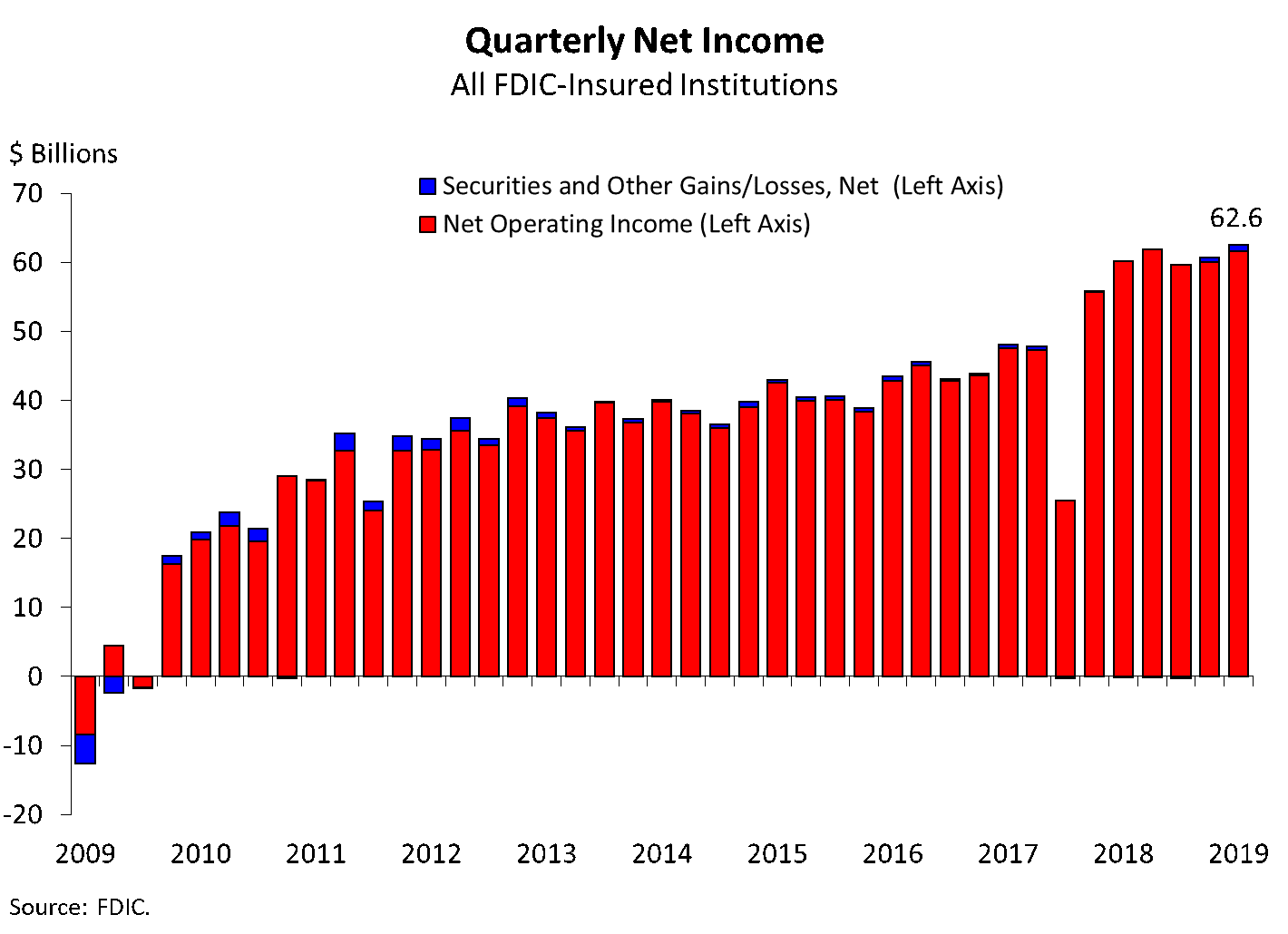FDIC-Insured Institutions Report Net Income of $62.6 Billion in Second Quarter 2019
FOR IMMEDIATE RELEASE
- Net Income Increases 4.1 Percent from Second Quarter 2018
- Net Interest Margin Remains Stable at 3.39 Percent
- Community Banks Report Increase in Net Income of 8.1 Percent from a Year Earlier
- Total Loan and Lease Balances Increase from the Previous Quarter and a Year Earlier
- The Number of Banks on the "Problem Bank List" Declines to 56
"While the banking industry reported another positive quarter and the banking system remains strong, the FDIC continues to encourage prudent risk management in order to remain resilient through economic cycles."— FDIC Chairman Jelena McWilliams
For the 5,303 commercial banks and savings institutions insured by the Federal Deposit Insurance Corporation (FDIC), aggregate net income totaled $62.6 billion in second quarter 2019, an increase of $2.5 billion (4.1 percent) from a year earlier. The improvement in net income is attributable to a $4.9 billion (3.7 percent) increase in net interest income. Financial results for second quarter 2019 are included in the FDIC's latest Quarterly Banking Profile released today.

"The banking industry reported another positive quarter," McWilliams said. "Quarterly net income expanded due to higher net interest income, loan growth increased, asset quality indicators showed modest improvement, and the number of ‘problem banks' continued to decline. Community banks also reported another positive quarter. Net income at community banks benefited from higher net operating revenue, and the annual rate of loan growth at community banks was stronger than the overall industry."
"With the recent lowering of short-term interest rates and inversion of the yield curve in the second quarter, new challenges for banks in lending and funding may emerge. Therefore, banks need to maintain rigorous underwriting standards and prudent risk management in order to support lending through the economic cycle."
Highlights from the Second Quarter 2019 Quarterly Banking Profile
Net Income Increases 4.1 Percent from Second Quarter 2018: Aggregate net income for the 5,303 FDIC-insured institutions rose by $2.5 billion (4.1 percent) from a year earlier, led by higher net interest income. Almost 60 percent of all institutions reported a year-over-year increase in net income and less than 4 percent of institutions were unprofitable. The average return on assets remained stable at 1.38 percent.
Community Banks' Net Income Increases 8.1 Percent from Second Quarter 2018: The 4,873 FDIC-insured community banks reported net income of $6.9 billion in second quarter 2019, up $522.7 million from a year earlier. Growth in net interest income (up 5.1 percent to $19.3 billion) and noninterest income (up 4.8 percent to $4.7 billion), as well as gains on securities sales (up 654.8 percent to $233 million) drove the annual increase in profitability. Combined growth in these areas offset increases in noninterest expense (up 5.6 percent to $15.3 billion) and provision expense (up 2.2 percent to $672.7 million).
Net Interest Income Increases 3.7 Percent from Second Quarter 2018: Net interest income rose by $4.9 billion (3.7 percent) from a year earlier to $139 billion in second quarter 2019. Slightly more than three out of four banks (75.1 percent) reported a year-over-year increase in net interest income. The average net interest margin remained stable from a year earlier at 3.39 percent.
Total Loan and Lease Balances Increase from the Previous Quarter and a Year Earlier: Total loan and lease balances rose by $152.2 billion (1.5 percent) from first quarter 2019. Growth among major loan categories was led by consumer loans, which includes credit cards, (up $42.2 billion, or 2.5 percent) and residential mortgage loans (up $38.3 billion, or 1.8 percent). Over the past 12 months, total loan and lease balances rose by 4.5 percent, a slight increase from the 4.1 percent annual growth rate reported last quarter. Commercial and industrial loans registered the largest dollar increase from a year earlier (up $142.7 billion, or 6.9 percent).
Asset Quality Indicators Improve Modestly: The amount of loans that were noncurrent (i.e., 90 days or more past due or in nonaccrual status) fell by $4.9 billion (4.8 percent) during the second quarter. Noncurrent balances declined for all major loan categories, especially for residential mortgages (down $2.1 billion, or 5 percent) and credit card balances (down $1.1 billion, or 8.7 percent). The average noncurrent loan rate declined by 6 basis points from the previous quarter to 0.93 percent. Net charge-offs increased by $1.1 billion (9.3 percent) from a year ago, and the average net charge-off rate rose to 0.50 percent.
The Number of Banks on the "Problem Bank List" Declines to 56: The number of problem banks fell from 59 to 56 during the second quarter, the lowest number of problem banks since first quarter 2007. Total assets of problem banks increased from $46.7 billion in the first quarter to $48.5 billion.
The Deposit Insurance Fund's Reserve Ratio Rises to 1.40 Percent: The Deposit Insurance Fund (DIF) balance increased by $2.6 billion from the previous quarter to $107.4 billion. The quarterly increase was mainly driven by assessment income, but unrealized gains on securities held by the DIF and a reduction in losses from past failures made considerable contributions. The reserve ratio increased by 4 basis points from the previous quarter to 1.40 percent.
Changes in the Number of Banks Reflect Mergers and New Bank Openings: During the second quarter, five new banks opened, 60 institutions were absorbed through merger transactions, and one institution failed.
Congress created the Federal Deposit Insurance Corporation in 1933 to restore public confidence in the nation's banking system. The FDIC insures deposits at the nation's banks and savings associations, 5,303 as of June 30, 2019. It promotes the safety and soundness of these institutions by identifying, monitoring and addressing risks to which they are exposed. The FDIC receives no federal tax dollars—insured financial institutions fund its operations.
FDIC press releases and other information are available on the Internet at www.fdic.gov, by subscription electronically (go to www.fdic.gov/about/subscriptions/) and may also be obtained through the FDIC's Public Information Center (877-275-3342 or 703-562-2200).
